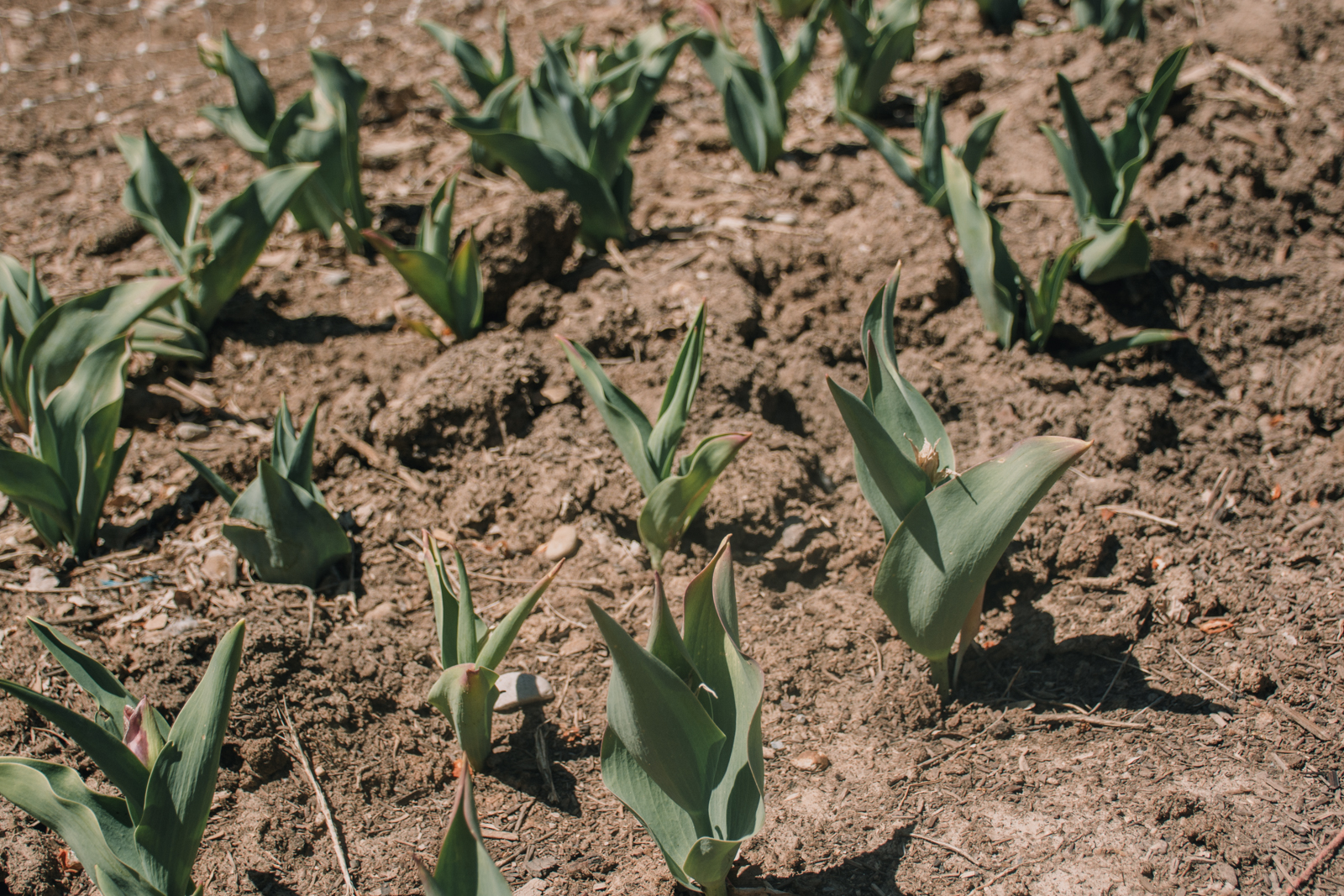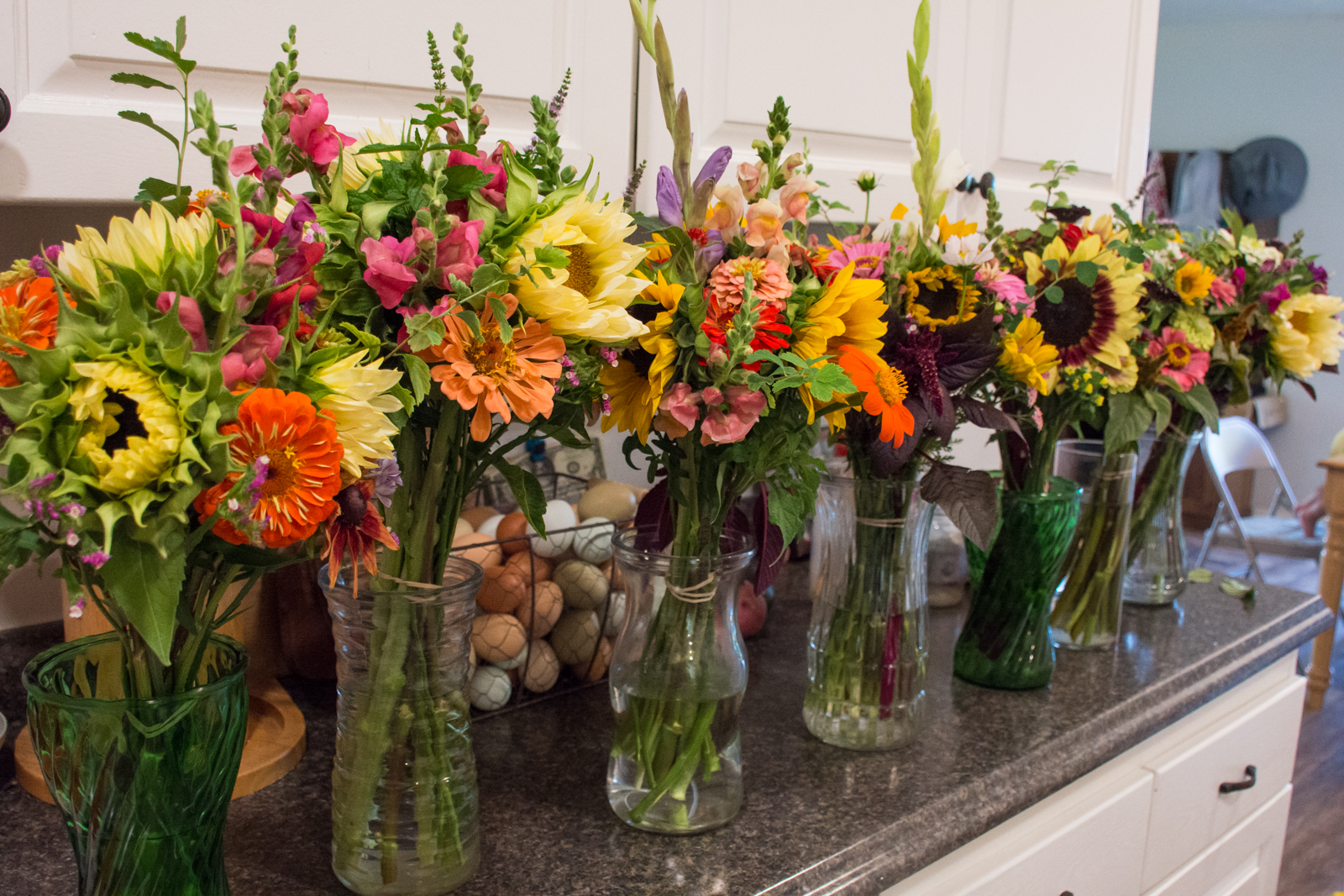
So you spent a lot of money on seeds or bulbs/tubers/corms, planted them in the ground, and waited (im)patiently for them to produce beautiful, lush blooms on tall stems that you could then sell by the armful.
But then…
They never sprouted.
They got hit by a heat wave and withered.
You forgot to water and the plants all flopped over and turned yellow.
The buds formed, but never bloomed.
Everything was too short to use.
Congratulations! You have successfully experienced your first (or second, or third) bout of crop failure as a new flower farmer!
Trust me, I’ve been there. My first year, I wasn’t great at knowing how to grow strong seedlings (I didn’t know that the secret was fertilizing weekly with this), but I WAS good at planting everything out when I was “supposed” to. So I transplanted out hundreds of hardy annuals in the recommended window (6-8 weeks before my last frost), and…almost everything died. Some died from frost, some died from me watering too soon after a morning frost, some died from bad compost…
It was awful.
Later in my first season, I transplanted out all of my celosia and cosmos into an area that had formerly been a cow corral that I was trying to transition over to garden beds. I’d amended the soil and watered like crazy, but I still lost 95% of my seedlings because the soil was just too salty.
Then last November, I planted about 1,000 tulip bulbs into the ground. I figured it would be pretty hard to mess up tulips, right?
Wrong.
I only had about 100 usable stems, and the rest didn’t come up, were too short, or withered on the stalk.
The first two failures I mentioned I could keep on the down-low, since I was brand new and didn’t have any customers waiting on those particular things. However, I’d been hyping up my tulips for weeks (months, really) so that when I (surely) had an abundance of tulips during a 3-week window in the spring, I’d have people interested in buying them. Therefore, I felt obligated to let people know of our crop failure via our social media channels so they wouldn’t be waiting on a crop that would never come in.
Although everyone was gracious and sympathetic and supportive, I still felt stupid. Embarrassed. Discouraged.
It seemed like everywhere I looked, people were posting pictures of their gorgeous tulips, and mine were completely shriveled in my back plot.
I’d lost the hundreds of dollars I’d spent on the bulbs. I’d lost the potential sales of people excited to buy tulip bunches in the spring. I had to scramble to find substitutes for the bouquet subscriptions I’d already sold, where I was really counting on the tulips as my main focal flowers.
Crop loss is hard; I won’t sugarcoat that.
But here are a few things that have helped me to be able to weather it a bit better when it does happen (because I’m sure these will not be the last experiences I have with it).
1. Announce the crop failure to your customers if necessary.
You don’t have to announce your crop failures in every case (such as if you’re just starting out and don’t have much of a customer base waiting on certain flower crops), but if you’ve advertised that you would have something by a particular date or a specific crop that you are no longer going to have, you need to let your customers know. For me, I did posts on my flower farm’s social media pages explaining what had happened and what it would mean.
Even though this is a hard step, it is also a great chance for you to see that most people are, in fact, very supportive and sympathetic, which can offer a boost when you’re coming off a disappointing loss. And as for social media, I feel like sharing the failures makes you seem a lot more relatable and authentic, which most people will resonate with.
2. Take everything posted on social media with a grain of salt.
For the week or so after we made our announcement on social media, I seemed to be flooded with tulip pictures wherever I looked, from the quintessential armfuls-of-blooms pictures on Instagram to the videos my favorite flower farmers were posting to their YouTube channels. It seemed like everyone but me had had massive success with their tulips, which just made me feel more stupid.
However, when I made the announcement to our social media, I had multiple flower farmers in my state comment that they had suffered major crop failures too with their tulips, which made me feel significantly less bad/stupid since I wasn’t the only one, and since the problem seemed to be more weather-related than I had originally thought. Not many of them were posting anything about it to their social media accounts, so because I was only seeing beautiful pictures of flowers everywhere, I was convinced my crop failure just had to be down to my own error. But, when I had the courage to just come out and say what had happened, I actually got not only the feeling of comfort and support because other people were also experiencing it, but also a lot of clarity about what might have actually caused it.
And even if the crop failure HAD totally been my fault?
Well, I’m quickly learning the more I talk to people who have been doing this a lot longer than I have that it’s pretty much par for the course in this line of work, so you just have to chalk it up to experience and try to not make the same mistake twice.
3. Do your best to figure out what went wrong.
Failure is an excellent teaching opportunity, even if it is an uncomfortable one. Failure can be one of the most motivating catalysts for looking for solutions and better methods, which have the potential to help ALL your future crops.
If I hadn’t been researching so heavily into why my tulips failed, I might not have unearthed some of the methods I plan to use next year (like the use of shade cloth), which will not just help tulips fare better in general, but which also tend to greatly help stem length. If I’d had adequate tulips this year, I would have likely been satisfied enough that I wouldn’t go looking for better practices and methods.
4. Always have backup plans in place.
Something I learned from last year’s June heat wave (and its subsequent wave of far-too-short stems) was that I always have to make sure I have a plan A, a plan B, a plan C, AND a plan D in flower farming, at least if I’m going to be offering CSA bouquet subscriptions that have to go out at certain times.
Because I’d learned that lesson last year, I’d tried my best to put in safety nets for this year, which included a wider variety of spring crops (including some I’d never originally intended to grow for cutting, like hyacinths), building a high tunnel where I can overwinter spring crops (like ranunculus and anemones), and forming good relationships with generous neighbors who are happy to let me use some of their blooms when my own aren’t producing as expected :). I had a neighbor offer me her tulips soon after I made the announcement that my own had all failed, and I also was able to get early-blooming irises from another neighbor for a later delivery of CSA bouquets since I didn’t have any tulips in my fridge during that period, as I’d originally planned.
Failures will pretty much always happen when you’re dealing with Mother Nature, so it’s definitely best practice to make sure you have plenty of backups.
5. Get out there and try again!
My oldest child just started playing softball for the first time this year. It was her very first time playing any sport, and she was understandably super nervous. She literally had never even watched a softball or baseball game before, so she had no concept of how everything was going to work.
My husband and I did our best to cram as much as we could in the few days of warning we had before her first practice and her first game (which translated to less than a week). Since her team is comprised of girls in three different grades (kindergarten through second), some of the girls had literally been playing for multiple seasons, especially if they’d started with t-ball.
We went to her first practice, and the team was practicing running the bases. On one of the rounds, my daughter’s foot didn’t touch the base, and another girl on the team exasperatedly yelled at her that her foot needed to actually touch all the bases.
My daughter’s always been sensitive and she was already feeling behind, especially as the first practice didn’t involve any explanation of the game as it was assumed most girls would already know. She left the field crying, feeling embarrassed and stupid.
I’d chosen to stay for the duration of the first practice since I could see that the coaches needed some extra adults around to help run some of the drills, so I was able to take her aside and talk to her for awhile. Even after giving her the most comforting pep talk in the world, my daughter still wasn’t sure she wanted to keep playing.
I managed to convince her to try batting and we’d see how she felt after, so she slowly made her way over to the plate. She missed the first several pitches, but then—TING! Her bat made contact, even if it was just a foul tip. With her excitement mounting over how close she’d gotten, she swung again, and hit the next one. After she got a few hits under her belt, the coach rotated her out to another drill, and she happily went back over to her team again and participated in everything for the duration of the practice.
When she came back to me after practice, her eyes were shining again with excitement, and she was elated with her burgeoning skills. When I noted to her that she seemed to have changed how she felt about the whole thing, she said, “Mom, when I was batting, I just thought: I’ve got this next one. I can do it…and that’s when I hit it! At first I was just feeling sad, but then when I got back out there and tried again and was able to do it, I didn’t feel sad anymore.”
We talked then about how the worst thing you can do after failing at something is to just give up, because then those feelings of embarrassment and sadness around the thing will just persist. The best thing you can do is get right back in and score yourself a victory so that you can regain your confidence that you can do hard things and learn and get better as you go.
All of this happened the same week as I’d had to announce our crop failure on social media. I’d been feeling sad and discouraged and a small part of me even wondered if it was worth going on with flower farming after this season.
As the words were leaving my mouth in my conversation with my daughter, I had one of those startling realizations of how what I was saying to her also applied to me. I realized that I just needed to pick myself up and keep on going until I got a win under my belt so that I wouldn’t keep wallowing in the shame of the failure.
It’s not like things automatically got easy after that realization, but I was at least able to push forward with confidence that I could try again next year and that one crop failure didn’t make ME a failure. I was able to get the replacements I needed to fulfill my CSA bouquet subscriptions, and I’ve now had several weeks of enough successes that I feel fully capable of going forward.
Crop loss is almost inevitable if you do agriculture for any length of time, so if you’re going to stay in this line of work, you’ll need to get some strategies in place for learning how to deal with it.
I hope that some of these suggestions and thoughts helped, and if this is something you’ve experienced before, I’d love it if you dropped a comment below and shared your insights!






